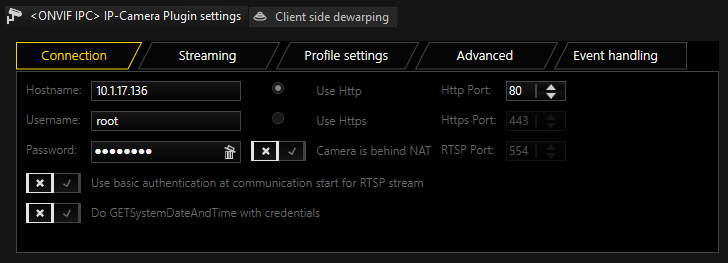Connection

Under Hostname, enter the IP address of the camera.
Control commands for the camera are sent by default through port 80.
ONVIF does use web services. The main-web service will be entered by using the IP address entered above. Via this main-web service the G-Core server will receive the information about RTSP Port automatically. Therefor the RTSP Port needed to be changed via the web page of the camera, and the G-Core server will receive this information automatically and use this port.
If you like to use HTTPS communication, you have to setup the camera to use HTTPS. For this you have to install or create a certificate on the camera.
If your camera is behind an NAT (Network Address Translation) web services might send wrong IP addresses and ports for communication.
If you using a Router or WAN including NAT, you need to enable the checkbox Camera is behind NAT.
Whether these ports need to be changed depends on settings in the camera itself.
To achieve maximum performance when starting the stream, you can send basic authentication with the option Use basic access authentication at communication start of RTSP stream. If this option is not selected, Digest authentication is used, which is the best choice in terms of IT security.
If you have trouble setting up a camera and cannot see pictures, you can enable the Do GetSystemDateDateDateAndTime with credentials option. Some camera manufacturers have received incorrect interpretations of the ONVIF standard and therefore require this checkbox. This is a workaround for wrong camera behavior.
If you are using a PTZ camera, enable the check mark Telecontrol Camera.
ONVIF unfortunately does not define default login data. It is important that the correct password is entered. Check the camera manufacturer's instructions to find the password that you must enter.